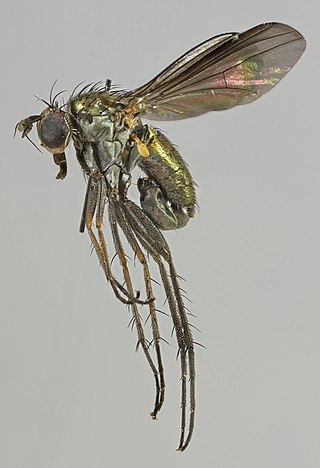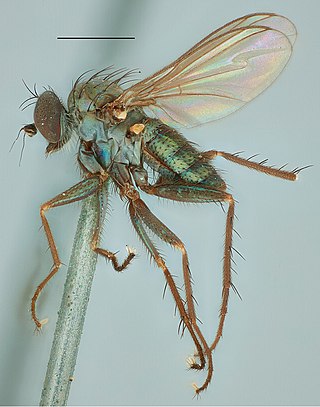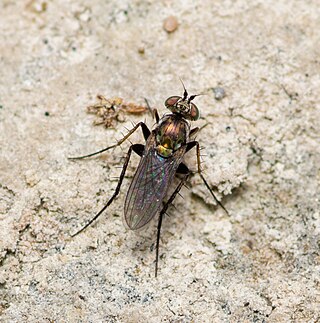
Hercostomus is a genus of flies in the family Dolichopodidae. It is a large genus, containing more than 483 species worldwide. Multiple studies have shown that Hercostomus is a polyphyletic assemblage of species.
Argyrochlamys is a genus of flies in the family Dolichopodidae. It is known from the Afrotropics, the Oriental realm, and the southernmost part of the Palearctic realm. The genus is closely related to the genera Pseudargyrochlamys and Phoomyia. Species of Argyrochlamys are restricted to ocean beaches, and are usually collected in the burrows of ghost crabs. Their ecological role within these burrows is currently unknown. Adults of Argyrochlamys have a non-metallic dull body color, ranging from pale yellowish brown to dark grey.

Asyndetus is a genus of flies in the family Dolichopodidae. There are more than 100 species described for the genus, distributed worldwide.

Chrysosoma is a genus of flies in the family Dolichopodidae. It is a large genus, with more than 200 species distributed in the Old World and Oceania.

Diaphorus is a genus of flies in the family Dolichopodidae. Lyroneurus was formerly considered a subgenus, but is now either treated as a synonym of Chrysotus or treated as a distinct genus.
Katangaia is an African genus of flies in the family Dolichopodidae. It was originally placed in the subfamily Rhaphiinae, though it was later transferred to Dolichopodinae. In 2005, based on a cladistic analysis of the subfamily, Scott E. Brooks excluded Katangaia from the Dolichopodinae. However, Grichanov (2012) retains the genus in this subfamily.

Liancalus is a genus of flies in the family Dolichopodidae. It contains at least 21 species distributed worldwide except in Australasia and Oceania. The genus includes some of the largest species in the family, with body length approaching 12 mm in some species.
Metaparaclius is a genus of flies in the family Dolichopodidae. It is known from Papua New Guinea and Australia. The systematic position and monophyly of the genus are currently ambiguous: the holotype specimen of the type species, Metaparaclius subapicalis, was deposited in the Hungarian Natural History Museum, which was destroyed during the Hungarian Revolution of 1956, and no other specimens of this species are currently known.

Paraclius is a genus of flies in the family Dolichopodidae. It is currently considered a polyphyletic assemblage of species.
Pseudohercostomus is a genus of flies in the family Dolichopodidae. It is distributed in the Oriental and Afrotropical realms as well as Chile.
Stenopygium is a genus of flies in the family Dolichopodidae. It contains two species which are found in the Neotropical realm, and is related to Pelastoneurus.

Sympycnus is a genus of flies in the family Dolichopodidae.

Tachytrechus is a genus of long-legged flies in the family Dolichopodidae.
Vetimicrotes is a genus of flies in the family Dolichopodidae. It is distributed in the Palaearctic realm. The genus was originally named Microtes by Theodor Becker in 1918. Afterwards, the name was found to be preoccupied by the grasshopper genus Microtes, so it was renamed to Vetimicrotes by C. E. Dyte in 1980.

Hydrophorinae is a subfamily of flies in the family Dolichopodidae. Several molecular phylogenetic analyses of the family have found evidence that the subfamily in its current sense is polyphyletic.

Dolichopodinae is a subfamily of flies in the family Dolichopodidae.

Diaphorinae is a subfamily of flies in the family Dolichopodidae.
Apelastoneurus is a genus of flies in the family Dolichopodidae. It includes 47 species from Africa formerly placed in Paracleius or Pelastoneurus.










